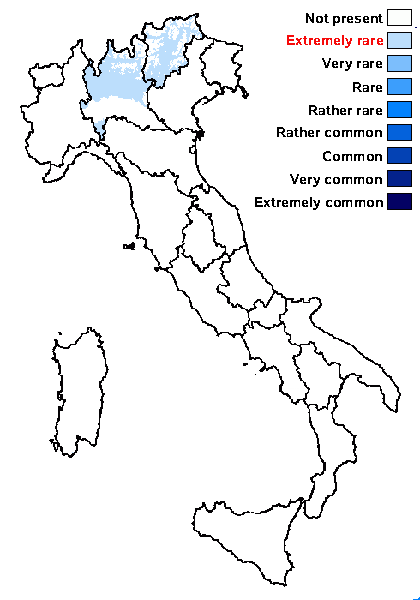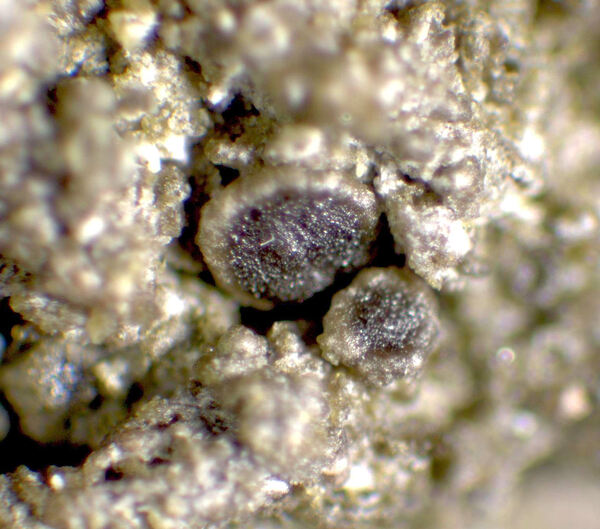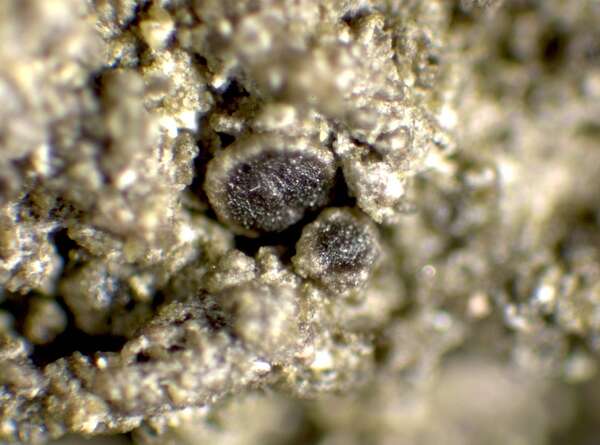Protoparmelia oleagina (Harm.) Coppins
in Coppins & al., Lichenologist, 24: 368, 1992. Basionym: Lecanora oleagina Harm. - Lich. France: 1023, 1913.
Synonyms: Lecanora furva H. Magn.?
Distribution: N - TAA (Nascimbene & al. 2008c, 2022, Nimis & al. 2015), Lomb.
Description: Thallus crustose, episubstratic, dark olivaceous brown to brown-black, dull, epruinose, continuous to rimose-areolate, densely covered in 0.07-0.15 mm wide and up to 0.4 mm high isidioid outgrowths with a one cell-layer thick rudimentary cortex. Apothecia very rare, lecanorine, up to 0.7 mm across, sessile, with a slightly concave to flat, blackish brown disc and a thick thalline margin even with disc. Epithecium brownish; hymenium colourless, c. 55 μm high; paraphyses coherent, branched in upper part, c. 2 μm thick, the apical cell c. 3 μm wide; hypothecium colourless; algal layer incomplete below hypothecium. Asci 8-spored, clavate, approaching the Lecanora-type, with a well-developed amyloid tholus and a distinct, non-amyloid axial mass. Ascospores 1-celled, hyaline, oblong, 9.5-15 x 3-3.5 μm. Photobiont chlorococcoid. Spot tests: thallus and medulla K-, C-, KC-, P-. Chemistry: traces of lobaric acid. Note: mostly on lignum, more rarely on acid bark in damp deciduous forests. This "western" species should be looked fore more intensively in Tyrrhenian Italy. The record from Lombardy is a "virtual" record. Sphinctrina anglica, an obligate parasite of this species, was reported from this region (see Nimis 1993: 659), based on Anzi, Lich. Lang. 212.
Growth form: Crustose
Substrata: bark and lignum
Photobiont: green algae other than Trentepohlia
Reproductive strategy: mainly asexual, by isidia, or isidia-like structures (e.g. schizidia)
Most common in areas with a humid-warm climate (e.g. most of Tyrrenian Italy)
Commonnes-rarity: (info)
Alpine belt: absent
Subalpine belt: absent
Oromediterranean belt: absent
Montane belt: extremely rare
Submediterranean belt: extremely rare
Padanian area: absent
Humid submediterranean belt: absent
Humid mediterranean belt: absent
Dry mediterranean belt: absent

Predictive model
Herbarium samples
Growth form: Crustose
Substrata: bark and lignum
Photobiont: green algae other than Trentepohlia
Reproductive strategy: mainly asexual, by isidia, or isidia-like structures (e.g. schizidia)
Most common in areas with a humid-warm climate (e.g. most of Tyrrenian Italy)
Commonnes-rarity: (info)
Alpine belt: absent
Subalpine belt: absent
Oromediterranean belt: absent
Montane belt: extremely rare
Submediterranean belt: extremely rare
Padanian area: absent
Humid submediterranean belt: absent
Humid mediterranean belt: absent
Dry mediterranean belt: absent

Predictive model
| Herbarium samples |
 Index Fungorum
Index Fungorum
 GBIF
GBIF




